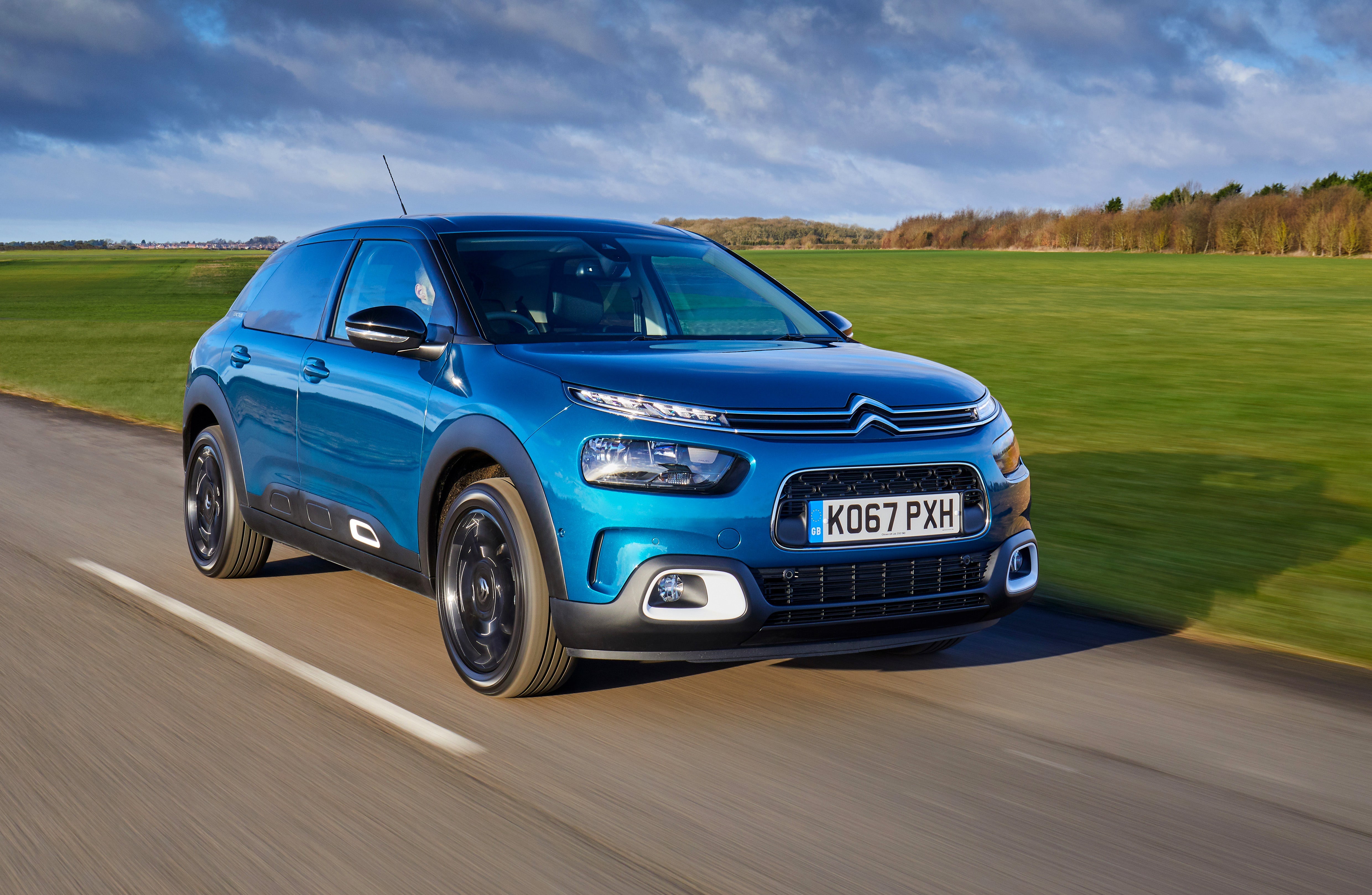Citroen C4 Cactus (2014-2021) Review
Written by Andrew Brady
Quick overview
Pros
- Funky design gives scope for personalisation
- Frugal diesel models
- Competitively priced
Cons
- Not the biggest or cleverest boot
- Fiddly touchscreen display
- Pop-out rear windows are not great for kids
Overall verdict on the Citroen C4 Cactus
"The Citroen C4 Cactus was an unconventional family hatchback that had a lot of character and style, but not enough substance to make it a proper all-rounder. The iffy cabin quality, coupled with overly soft suspension and so-so driving dynamics, made it hard to recommend over a diverse range of more talented alternatives."
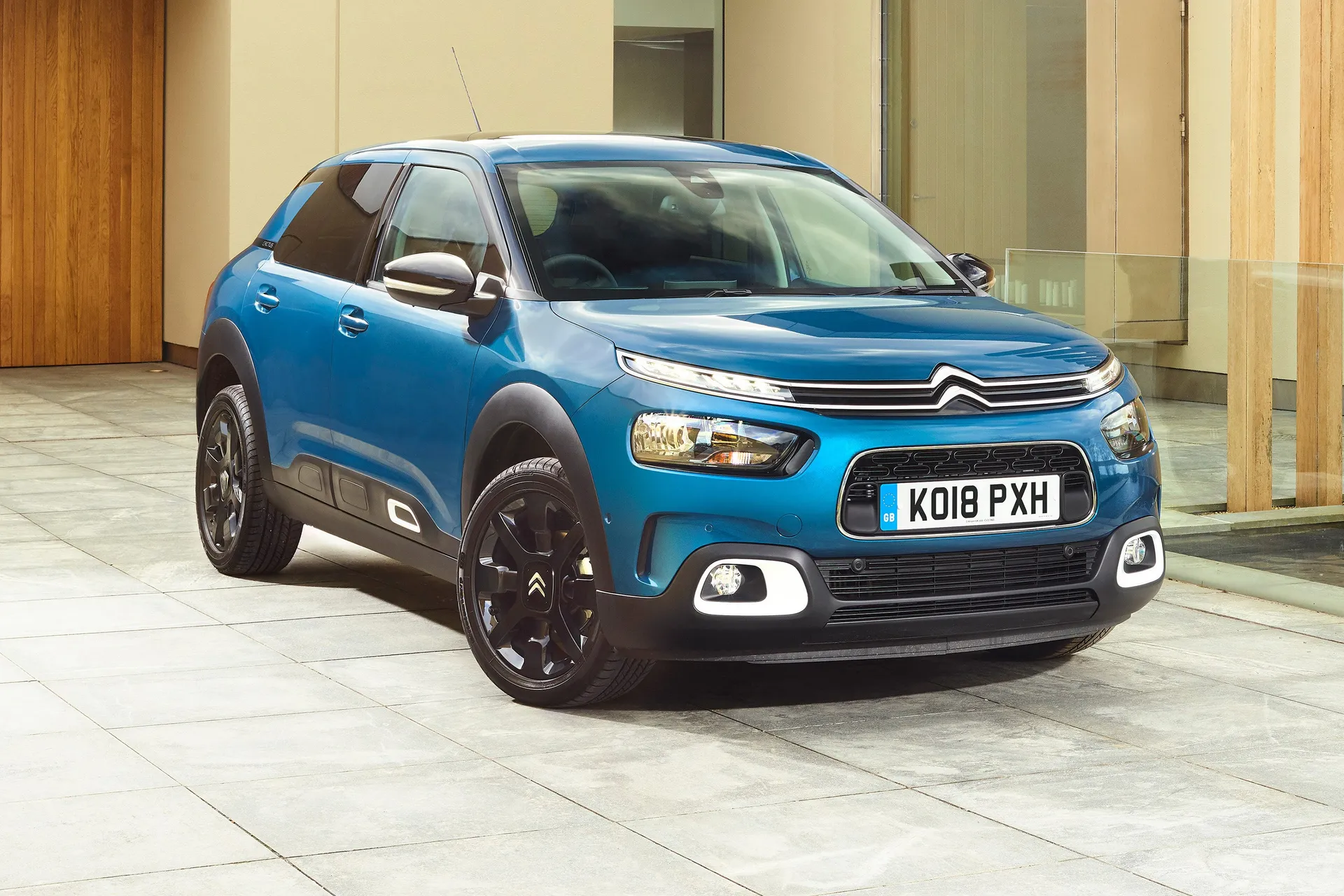
The Citroen C4 Cactus was the French brand's attempt to cash in on the surging popularity of crossovers, but unlike many cookie-cutter small SUVs, this was a car that defied narrow definitions. It was stylish but cheap, a roomy family car that was very light and put its focus on interior comfort and fresh design above all else.
It was also - despite plenty of media attention - a bit of a sales flop. It may have been a cheap car but the outlandish looks and vivid colour schemes proved too polarising and it didn't have the high-driving SUV position that buyers like.
Fast-forward to 2018, and Citroen took another stab at the Cactus with a facelifted model, turning it into a distinctive family hatchback. Firstly, the brand toned down the looks. The latest Cactus had less garish paint hues, no roof rails and no rubber 'Airbump' protective panels in the doors. It still looked unusual, but not like a lime-coloured spaceship.
Citroen also doubled down on comfort, with a new suspension setup and super padded sofa-like seats. If you could get on with the unusual driving position, this was one of the most cosseting seats on the market. It felt like an armchair, with your legs propped up and the memory foam-like cushions giving loads of support.
Passenger space was decent and the cabin had some smartly finished details with a minimal, modern look. However, it was also built down to a price, with cheap materials in places and quirks like pop-out rear windows.
Originally it was offered in three different trims: Touch, Feel, and Flair but customers wanted more standard equipment than the basic cars had, so in the end, the Cactus was only available as the fully-loaded Flair. This gave it a higher starting price, but it did at least come with very generous standard specifications and lots of safety tech.
Despite the impressive equipment haul, the C4 Cactus was very light for a five-seat family car, giving it superb fuel economy. The most efficient diesel version achieved well over 60mpg and even the quickest 1.2-litre turbo petrol claimed an official 46.3mpg. That was with the automatic gearbox.
For us, the entry-level 1.2 petrol with a six-speed manual was the best fit. It may have been small in size, but it felt usefully quicker than its 110PS would suggest, with decent oomph in gear and solid refinement. It felt easier to drive smoothly than the previous five-speed manual, but the handling trailed most of its rivals.
Its super-soft suspension gave the Cactus a calm, low-speed ride and it glided over speed bumps without disturbing its passengers, but the trade-off was roly-poly cornering and poor body control. The steering was light, but too remote and the grabby brakes and vague gearshift meant driving smoothly demanded concentration.
When you combined these dynamic shortcomings with its below-average boot capacity, a fiddly touchscreen infotainment system and a four-star Euro NCAP safety rating, the negatives began to outweigh its positives. Citroen made a stylish attempt to step outside the mainstream with the C4 Cactus, but it was destined to remain a niche car.
The Citroen C4 Cactus was effectively replaced in 2021, read our Citroen C4 review for an in-depth verdict. There is also an electric car version, the Citroen e-C4. Looking for a used car for sale? We've got 100s of Citroen Approved Used Cars for Sale for you to choose from, including a wide range of Citroen C4 Cactus models for sale.
Is the Citroen C4 Cactus right for you?
The Citroen C4 Cactus was an unusual car for unusual people. The first version was a bold style statement that came in outlandish colours and turned heads wherever it went, mostly competing with compact crossovers.
The facelifted model from 2018 (with its toned-down design) was pitched as a rival to sensible family hatchbacks that looked as conservative as a stiff white collared shirt, so the Citroen is still an interesting and quirky alternative buy.
If you wanted your family car to have low running costs, a comfortable ride, and an affordable price (without feeling like a soulless budget option) the Citroen C4 Cactus was tailor-made to fit your needs, but there were caveats.
Mainly, these had to do with the way it drove. It had light steering with an artificial, disconnected feel, grabby brakes and a notchy gearbox that wasn't very precise. The soft suspension was comfortable, but it wasn't for everyone.
What’s the best Citroen C4 Cactus model/engine to choose?
If you want a truly distinctive design that looks like nothing else on the road, then the original Citroen C4 Cactus will be hard to beat. It's peculiar - but never dull - although it's strange 'airbumps' were not known for durability.
However, once you look past the aesthetics, the revised post-2018 model is a much better car, with many of its predecessor's irritating kinks ironed out. The seats were more comfortable, and it was quieter with a nicer gearbox.
We like the comprehensive amount of kit in the Citroen C4 Cactus Flair, but you'll save yourself a chunk of change by buying a used Feel version, which still has all the important everyday stuff like air-con, cruise and DAB.
As for the engines, we'd avoid the entry-level PureTech 82PS petrol unless you're desperate for cheap insurance. It’s too slow to keep up with traffic outside city limits. The turbocharged versions of the same unit are a lot more flexible and fun to drive, while still returning decent fuel economy. We'd get the 110PS car.
What other cars are similar to the Citroen C4 Cactus?
We could be flippant and say there's nothing quite like it, but that's no longer as true as it once was. It had the style and personalisation options to attract small SUV buyers but rided lower than most rivals. It wasn't as good for carrying luggage as cars like the Renault Captur, Peugeot 2008 or SEAT Arona.
The latest model was toned down a lot (we miss you, curvy roof rails) to compete with conventional family hatchbacks but it stood out in a car park chock-full of the usual Vauxhall Astra, Volkswagen Golf and Skoda Octavia suspects.
While they are less interesting, all of those models had fewer compromises than the Citroen was saddled with.
As a used buy, the Kia Soul checks a lot of the same boxes as the Cactus, with interesting looks, a spacious cabin and loads of standard kit. It's not as softly sprung as the Citroen, but the cabin feels more robust. It also comes with a seven-year warranty from new that's transferable to multiple owners, for total peace of mind.
It's worth checking out the new Citroen C3 and C3 Aircross alongside the C4 and C4 X if a new car is of interest.
Comfort and design: Citroen C4 Cactus interior
"Much like its bold exterior styling, the unusual driving position in the Cactus won't be for everyone. It has the standard range of height and reach adjustment to the steering wheel, driver's seat, and lumbar support too."
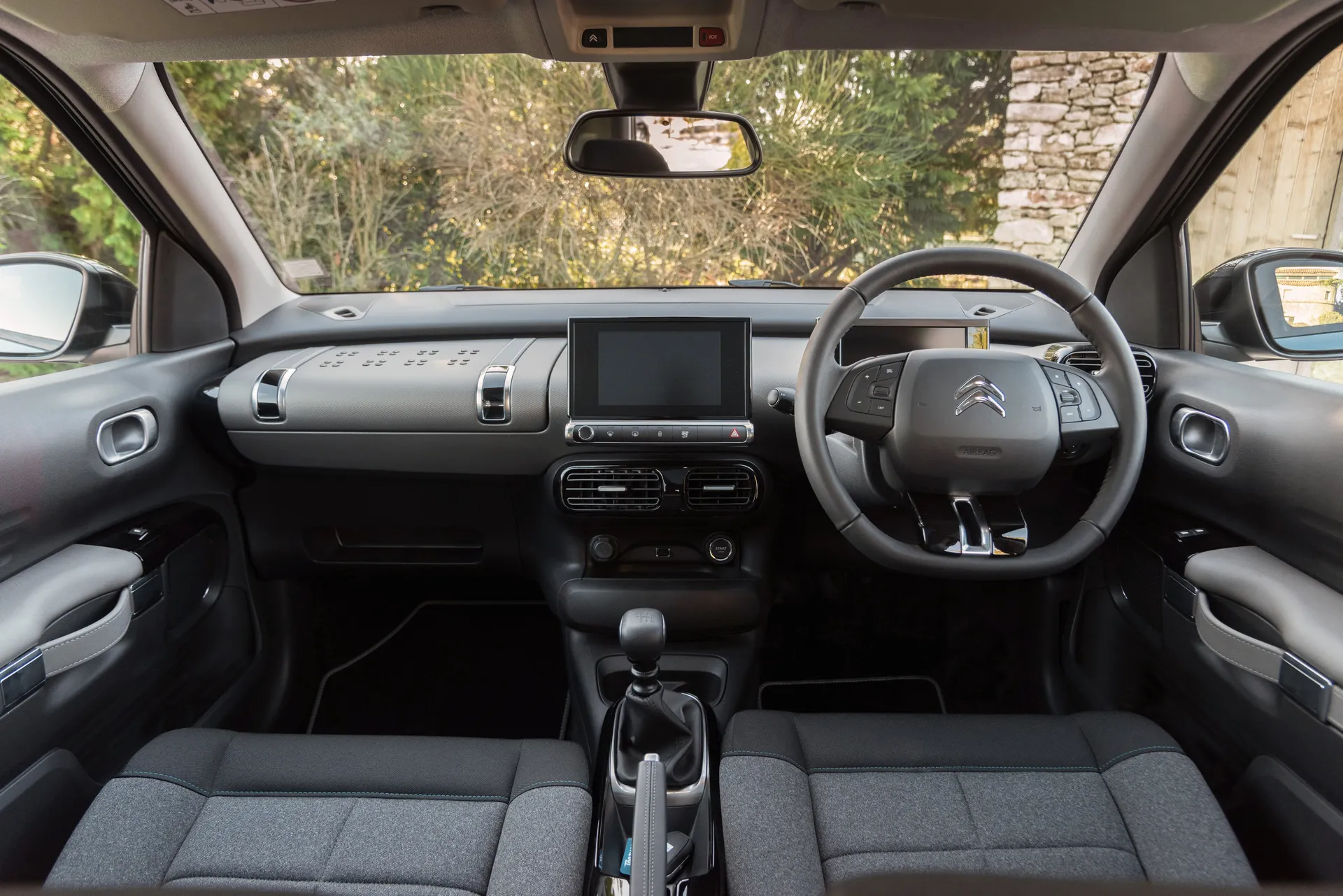
However, the low base of the squidgy soft seats was angled upwards, forcing your legs to rise. As a result, it felt like you were sinking into it rather than perched on top of it. This could cause issues for taller drivers, so check that it suits you before buying.
Citroen didn't change much inside the Cactus for its 2018 facelift. It still had an unusual-looking cabin, with plenty of nice design touches, including the ‘treasure chest’ glove box built into the top of the dash, leather straps in the doors for pulling them shut and an integrated 7.0-inch infotainment touch screen that controlled all the main functions.
It was so minimal, that you would find more buttons on the steering wheel than on the centre console. You got a volume knob, a switch for the front and rear screen defrost and door locks but that's about it. It was hard to lose your bearings then, but the pared-down mantra also meant your front passenger only got a single air vent.
Some other quirks, like the lack of a rev counter and the pop-out rear windows (electric rear windows were not available, even on top-spec cars) would've surely made passengers feel claustrophobic in the back.
The thickly padded seats were a real boon on longer journeys though, as long as they fitted your size and shape.
Quality and finish
The thoughtful design of the dashboard and some stylish interior details made the C4 Cactus look upmarket, with the attractive seat fabrics, dense soft-touch plastics on the centre console and a smart gear selector.
Everything you touched regularly had a reassuring heft and decent finish, but the Cactus was designed to be affordable and in places where cost-cutting was more obvious. Most of the trim below the eye line was hard black plastic - as were the door cards - but the stark contrast with the interior's posh bits made them stand out.
Few family hatchbacks had such an interesting-looking interior, but most delivered a more consistent build quality. One moment your hand was met by soft stitched leather and the next, rough textured plastic.
At least Citroen spent money in the right places. The important areas you'll interact with regularly being nice to hold is preferable to having a beautifully finished fuse box cover, but this patchy overall impression gives you doubts about the longevity of this interior.
Infotainment: Touchscreen, USB, sat-nav and stereo in the Citroen C4 Cactus
Whichever C4 Cactus you choose, you'll control its media functions through a smart-looking 7.0-inch colour touchscreen mounted within convenient reach of the steering wheel. It was surrounded by a black bezel with two rows of touch-sensitive buttons, which let you quickly snap between its different functions.
It was backed up by a charmingly retro LCD speedo, plonked in front of the driver. Weirdly, the second display had no rev counter and was a far cry from the slick 'Virtual Cockpit' digital dials that were available in the Audi Q2.
Indeed, this was far from the best infotainment system around. Earlier entry-level models missed out on many of its best features. All C4 Cactus models have DAB digital radio, Bluetooth, Apple CarPlay, Android Auto smartphone mirroring and even a built-in nav and sim card.
It was a generous feature set, but using all those functions could be a test of patience. The shortcut buttons were particularly inconsistent in their response, sometimes requiring several presses to work properly.
There were no separate controls for the heater either, so if you wanted to change the fan setting or temperature it was a three or four-stage process rather than simple dial twisting.
Space and practicality: Citroen C4 Cactus boot space
As with so much about the Cactus, practicality was a frustratingly mixed bag. There were lots to like, with some clever solutions to interior storage - especially the large top-hinged dash compartment - but plenty of niggles.
The slimline centre console and big windows gave a fantastic feeling of space in the front and two adults sat comfortably in the back seats, with knee-room to spare. The headroom was tighter though, especially if you fitted the optional panoramic (fixed) glass roof, so we'd avoid cars with this unless you've got younger children.
Sitting in the back on long journeys was made easier with pockets in the front seat backs, deep door bins for drinks bottles, an armrest each, and a shallower extra cubby in the door for sweets, phones or loose change.
It didn't have charging ports or cupholders and pop-out rear windows meant you couldn't let a cool breeze in.
Both outer seats had Isofix mounts and top tethers for fitting child seats. With wide-opening doors and easy access to the anchor points, doing so was straightforward, but you'd struggle to fit an adult between two.
Unlike many small SUVs back then, you couldn't slide the rear seats to increase the amount of room, but they did split and fold.
Thoughtful touches like the grippy rubber dots on the top of the dash were tempered by design oversights like the shallow front cupholders and a phone tray that was too narrow to hold the majority of modern smartphones.
The boot was a reasonable size, but gave less flexibility than its rivals, with no false floor or load dividers. With the seats up, you got a 358-litre space, enough for a buggy and several small suitcases, but the access wasn't great, with a high loading lip to lug things over and a narrower boot aperture than many rival family hatches.
The original Citroen C4 Cactus had a one-piece rear bench, but the newer model received a traditional 60/40 split-folding layout that gave more flexibility, but there was still a significant hump in the floor when they were folded.
Regarding external dimensions, the Citroen C4 Cactus measures 4170mm, 1714mm wide and 1480mm tall.
Handling and ride quality: What is the Citroen C4 Cactus like to drive?
"Citroens of old were prized for their soft, smooth ride quality and the brand has attempted to reclaim that reputation with the updated Citroen C4 Cactus."
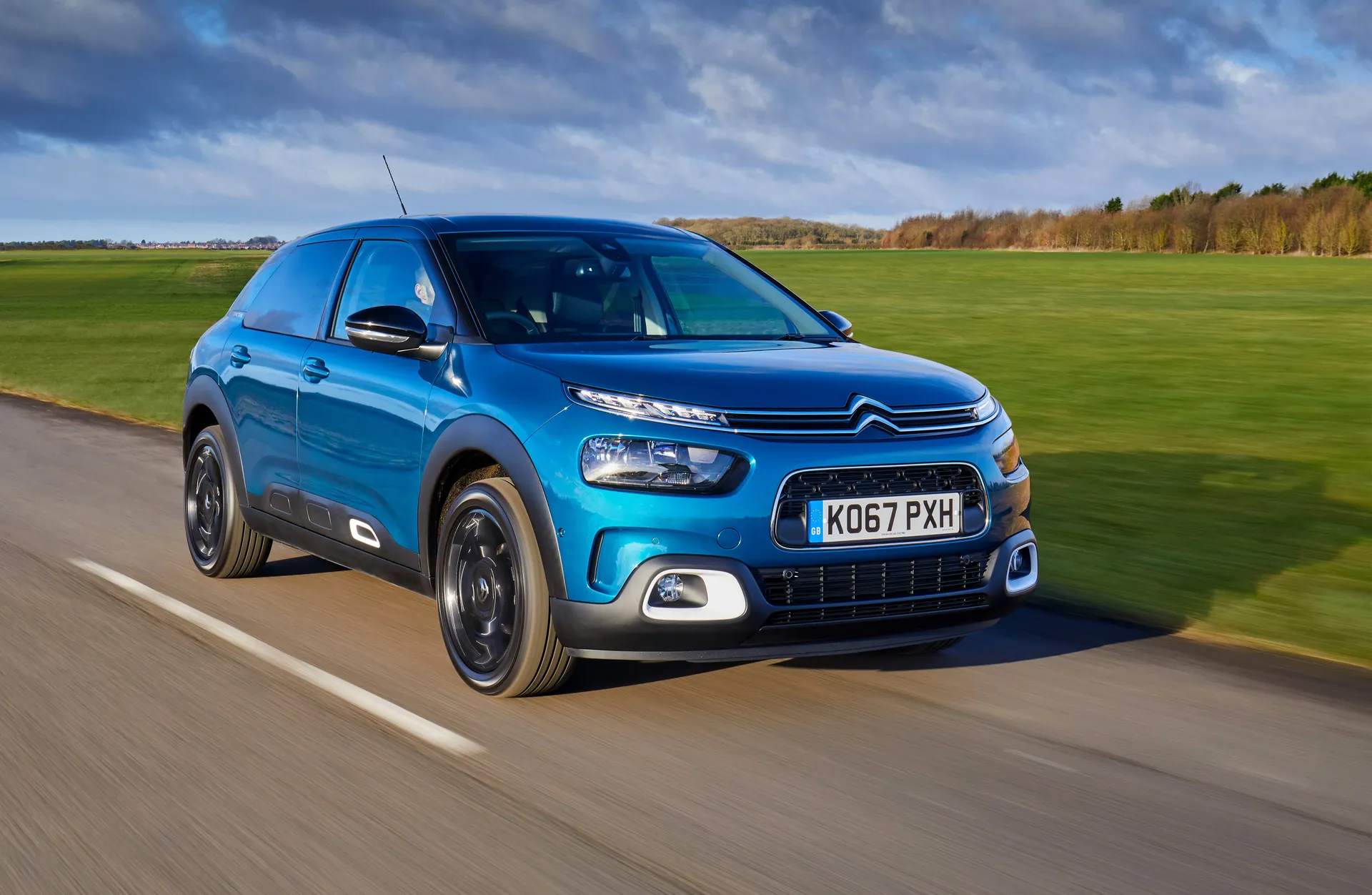
The pre-facelift car was already pretty spongey and would crash over sharper imperfections once its soft springs ran out of travel. Citroen added hydraulic ‘cushions’ inside the post-2018 Citroen C4 Cactus suspension to help it soak up speed bumps and dips much better. It worked in some situations, but there were some rather unwelcome side effects.
While the super-soft setup helped with smaller bumps and ripples, it came at the expense of body control. So the whole car leaned dramatically in corners. This roly-poly nature made it feel unstable and bouncy on uneven roads. The quicker you hit a bump, the more pronounced this pitching movement got.
How you felt about this depended on how and where you drove the Citroen C4 Cactus. Some liked its pillowy suspension at lower speeds, but many rivals smoothed out the road surface without losing any composure. The artificially light, vague steering didn't help matters and required constant corrections to stay straight.
That made it hard to judge how much grip there was and although the C4 Cactus handled tidily enough once you got past its tendency to pitch and roll through corners, with reasonable grip, it wasn't much fun. We would've forgiven it if the Citroen C4 Cactus was soft and composed, but one without the other left it lopsided.
Ultimately, it was a car that demanded to be driven slowly, with steady and careful inputs from the driver to remain comfortable. To us, it was rather one-dimensional to drive.
What engines and gearboxes are available in the Citroen C4 Cactus?
There were two engines available with the Cactus, a petrol and a diesel, each offered two power outputs. There was no hybrid car or PHEV option nor an electric guise.
The PureTech petrol was a 1.2-litre three-cylinder turbo with either 110PS or 130PS, the BlueHDi diesel a 1.5-litre with 100PS or 120PS. The less powerful models were paired up with a six-speed manual, while the quicker cars got a six-speed automatic, although Citroen previously let you have the 1.2-litre 130 with a manual gearbox.
There was decent variety, but for our money, the best option is the entry-level petrol. Its 1.2-litre PureTech is still a terrific engine. Zingy, and eager to rev and quick enough to keep up with other traffic.
The newer six-speed manual was a lot better resolved than the shonky five-speed that was fitted previously, with a more direct shift action and better-spaced ratios, so it was easier to keep the engine spinning smoothly.
Driving smoothly in the early models was challenging because of the oddly weighted controls. The clutch was abrupt, the throttle overly sensitive and the shift action vague, which made stop-start traffic really onerous.
Choosing an automatic didn't improve things much, since the EAT6 transmission was a bit sluggish in its responses and could be jerky when changing into a higher gear. It was at least been improved with the 2018 update.
These engines all had decent performance, but the 1.5-litre diesel was incredibly economical and had a useful extra slug of torque.
Refinement and noise levels
How old your Citroen C4 Cactus is will have a big impact on how quiet it will be, especially at speed. In its quest to shed weight, Citroen shaved sound insulation out of the original model increasing road, wind and engine noise.
Customers didn't appreciate this stripped-back approach, so in the 2018 refresh, Citroen added it back in, fitted a new 'acoustic' windscreen and thicker side windows. They even went through the trouble of installing new door seals and adding soundproofing to the dash. This was all to make the Citroen C4 Cactus feel a bit more demure at speed.
Those changes were not as successful as the brand might have hoped for. Road and tyre noise on the newer car was rarely intrusive, but you still heard more wind noise in the Citroen than its Volkswagen and Skoda rivals.
The 1.2-litre petrol was smooth at low speeds around town and settled down when cruising but could be gruff at higher revs when pushed. It also sent a gentle buzz of vibrations through the pedals and gearstick but this was quite common with three-cylinder engines.
Picking a diesel meant rumbling engine noise - especially when cold - was a constant companion. Once again the later model did a better job of disguising it than the older version, which had a five-speed gearbox.
Safety equipment: How safe is the Citroen C4 Cactus?
The Cactus featured an impressive array of safety kit, especially in later models.
Previously, every car in the line-up came equipped with passive essentials like six airbags, electronic stability and traction control, you could also set and control your speed with the limiter function on the cruise control.
That little bundle helped the Citroen C4 Cactus gain a four-star (out of five) Euro NCAP crash safety rating in 2014. That wasn't too bad, but remember most of its rivals achieved a five-star score. Those cars also did better in the individual categories, with rivals like the Skoda Scala getting a near-perfect 97% for adult protection.
The later Flair trim brought a generous suite of active assistance systems that would almost certainly help the Citroen gain that elusive final if tested again.
The driver attention alert system warned you if the car thought you were getting sleepy and drifting out of lane. It monitored your distance from the road markings and pinged a visual and audio warning if you began driving too erratically.
Add to that lane departure warning, a system that showed you the local speed limits, hill start assist that got you going again on steep junctions, front and rear parking sensors plus a parking camera and it was an extensive list. Auto-emergency braking was also standard.
A red 'SOS' button sat next to the interior lights, which used the car's sim card to call the emergency services if the worst happened. If the full kitchen sink wasn't enough, you could also add a blind spot monitor and a spare wheel as options, although you got a foam repair kit as standard.
MPG and fuel costs: What does a Citroen C4 Cactus cost to run?
"The Cactus was a light car - no model weighed much over a tonne - and you could feel the benefits at the pumps. A 1.2-litre petrol with 110PS and a manual gearbox returned an official 48.7mpg, and based on our Real MPG test figures, expect you would still get fairly close to that figure on the road as long as you drive it sensibly."
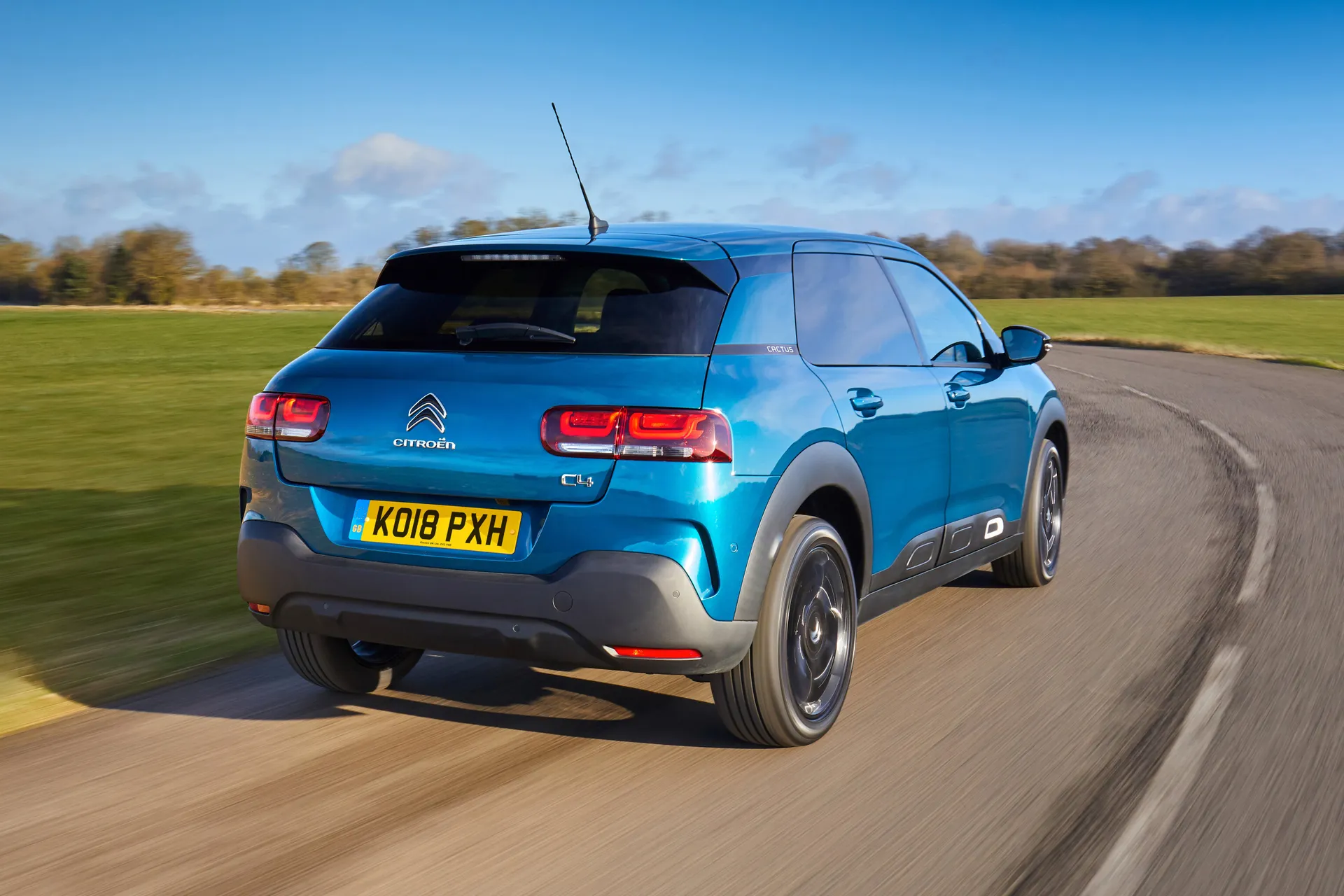
We really liked this engine, but the 1.5-litre BlueHDi 100PS was better for higher mileage. It was extremely frugal for a reasonably sized family car; over 70mpg in the real world.
However, we'd avoid the automatic models if running costs are a priority as they were around 10% thirstier.
Citroen C4 Cactus reliability and warranty
Citroen as a brand doesn’t enjoy the best reputation for reliability and the C4 Cactus followed that trend, with owners reporting a glitchy infotainment system. Some cars have had issues with the automatic gearbox, and even pieces of bumper trim coming unstuck.
In the latest HonestJohn.co.uk Satisfaction Index, Citroen was placed 26th out of 29 makes, behind Peugeot and Mini.
Citroen C4 Cactus insurance groups and costs
Luckily, the Cactus is still fairly cheap to insure if you buy the right car. The 1.2 PureTech Feel (5d) ETG is the cheapest in group 7. The non-ETG car is group 9 while the 110ps variant is group 15.
The dearest to insure is the 1.6 BlueHDi at group 19.
VED car tax: What is the annual road tax on a Citroen C4 Cactus?
Another benefit of the C4's featherweight design is its low running costs. According to the old NEDC tests (later replaced by WLTP), only one emitted more than 110g/km of CO2. The 110 Flair PureTech EAT6 was the culprit, emitting 118g/km.
Most emit around 90-107g/km, meaning they'll cost around £190 per year to tax. It's worth checking, however, as the C4 Cactus awkwardly straddled two tax categories (pre and post-1 April 2017).
Citroen C4 Cactus price
"Early 2014 cars are priced from £2,700 and there are many cheap category cars available, although we'd recommend steering clear of these"
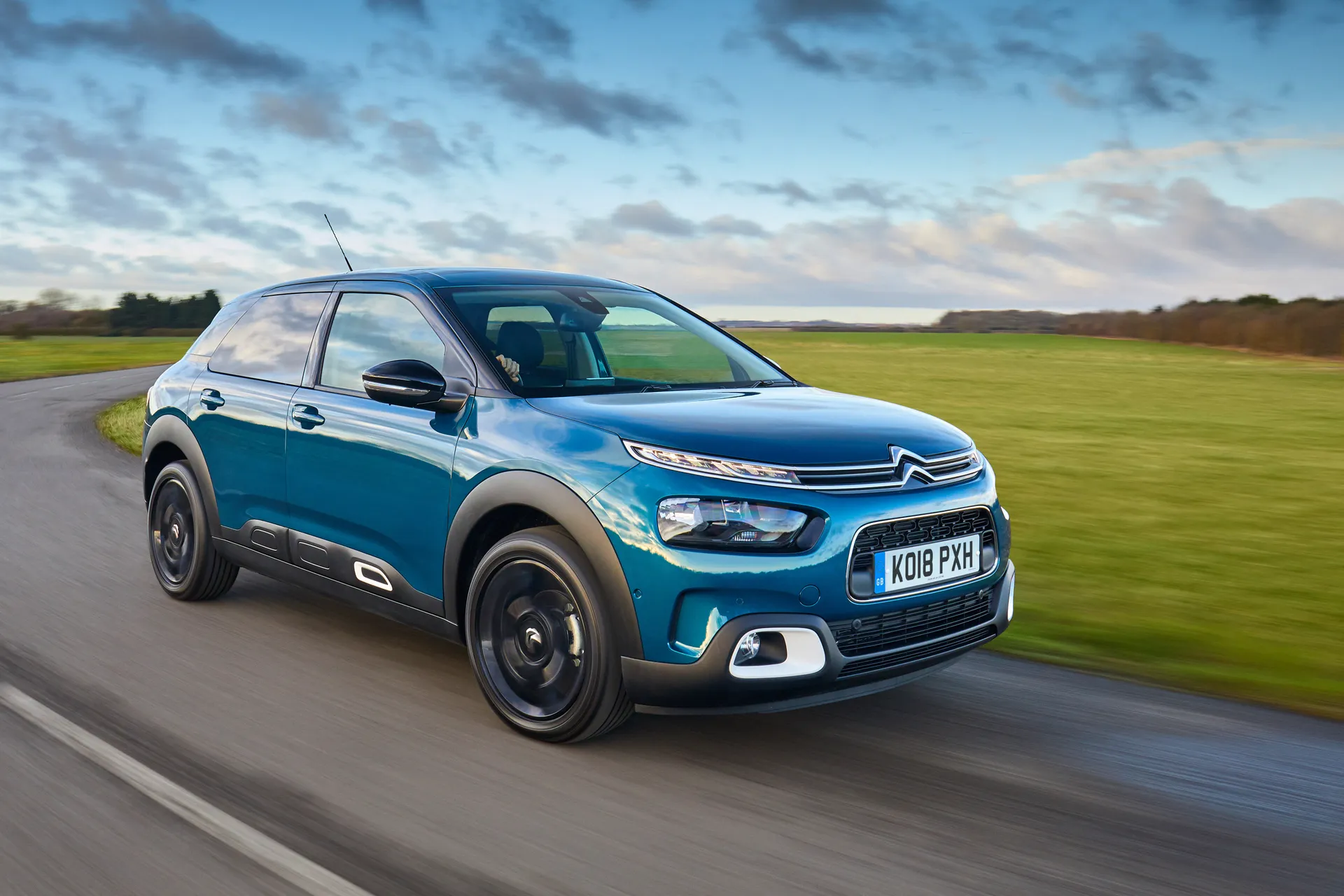
Most of the cheaper cars are 1.2 PureTech models, a 1.6 BlueHDi may occasionally pop up too. Early low-mile cars start at just under £5,000, but newer 2016 and 2017 cars can also be had for this price with around 50,000 miles.
2018 and up cars often demand around £8,000 while low-mile 2019 cars fetch around £10,000.
Trim levels and standard equipment
Newer Catcus' were a single specification. The good news is that the fully loaded Citroen C4 Cactus Flair model had many goodies to boot.
As standard, the Citroen C4 Cactus Flair received 17-inch wheels, a 7.0-inch touchscreen with integrated sat-nav, rear parking sensors and rearview camera, DAB radio, Bluetooth, climate and cruise control and smartphone mirroring. It was so well appointed that the only options available were the panoramic glass roof and metallic paint.
If you bought an entry-level Citroen C4 Cactus Touch trim, you were still fairly well catered for, with the same touchscreen, DAB radio, USB connectivity and cruise control, but no air-con or Bluetooth. It also had a nasty plastic steering wheel and missed out on the excellent safety features standard in the Flair.
The better value Citroen C4 Cactus Feel trim had a nice balance of kit and is the one we'd recommend.
Ask the heycar experts: common questions
Is the Citroen C4 Cactus a good car?
Why is the Citroen C4 Cactus so cheap?
Is the Citroen C4 Cactus an SUV?
Is the Citroen C4 Cactus a 4x4?
What is the difference between a C4, C4 Cactus and C4 Picasso?
Get our latest advice, news and offers
Keep me updated by email with the latest advice, news and offers from heycar.
By submitting you agree to our privacy policy
